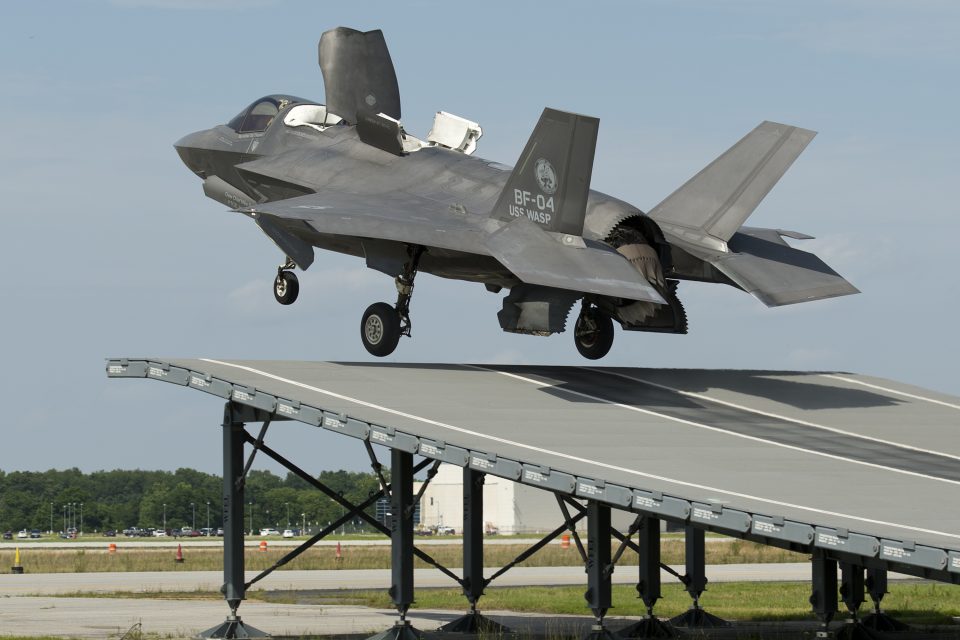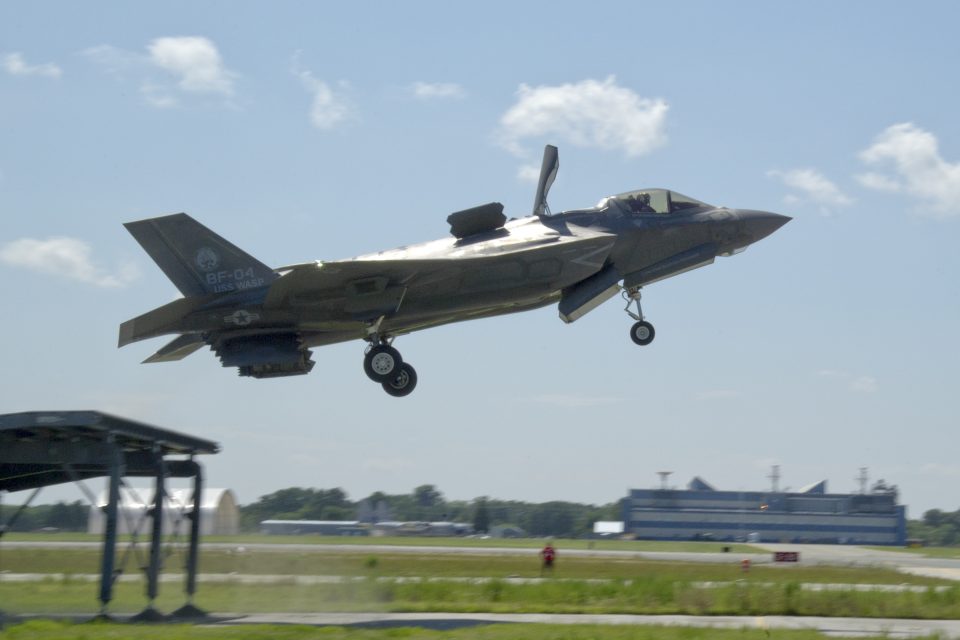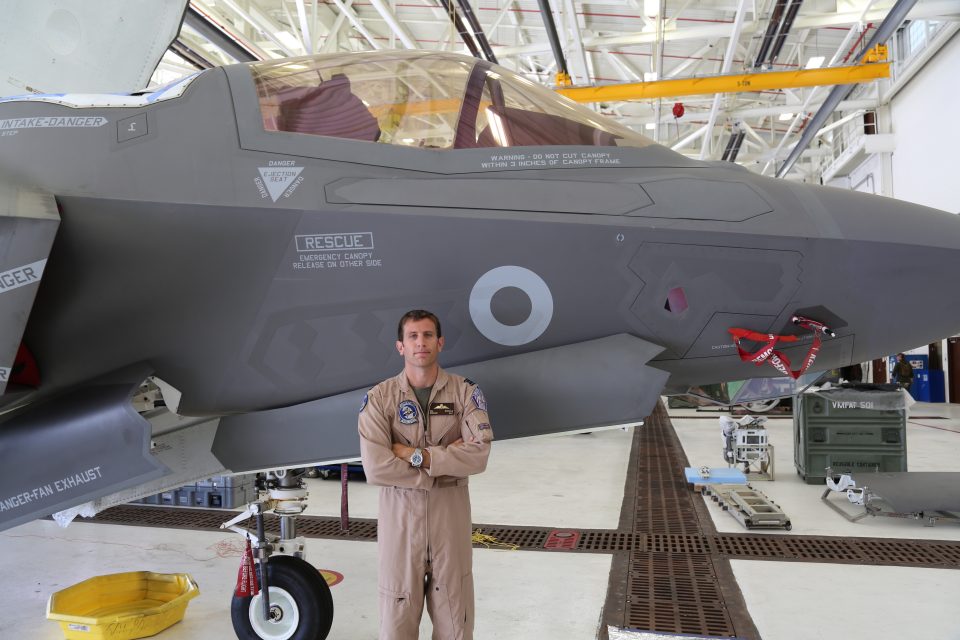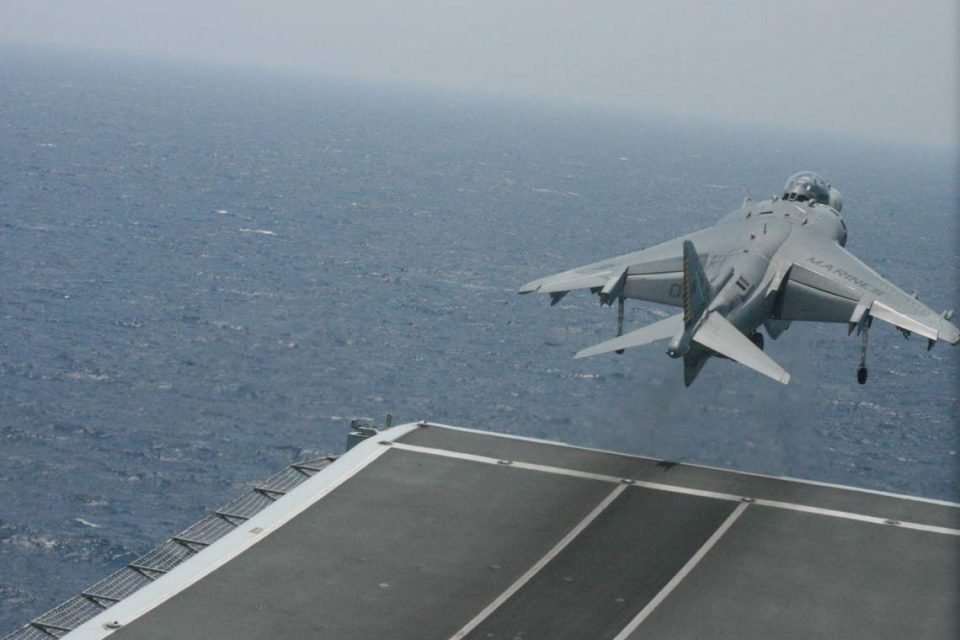2017-10-21 In a piece published September 12, 2017, the UK Ministry of Defence highlighted the role of the F-35 Integrated Task Force.
Royal Navy Commander Nathan Gray is a member of the Integrated Test Force alongside other F‑35B Lightning developmental test pilots from the RAF, USN, USMC and industry located in Naval Air Station Patuxent River, Maryland, USA.
With over 10 years of Harrier experience, Cdr Gray has conducted numerous operations from both land and sea, but only recently experienced how the F-35B performs a Ski-Jump take-off:
“With both the Sea Harrier FA2 and to a lesser extent the Harrier GR7/9/AV8B, the pilot was very much in-the-loop and had to execute near-perfect timing and control to safely execute a Ski-Jump launch.
With the F-35B, the whole experience is much more controlled and predictable with the majority of the launch autonomous, allowing the pilot to focus on the mission ahead rather than being distracted by the launch.”
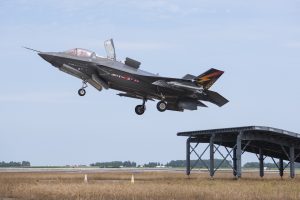 BF-1 Flt 675 piloted by Cdr Nathan Gray, ski jump testing with external pylons and AIM-9x from NAS Patuxent River, MD on 16 June 2017
BF-1 Flt 675 piloted by Cdr Nathan Gray, ski jump testing with external pylons and AIM-9x from NAS Patuxent River, MD on 16 June 2017
Each F-35 Developmental Test aircraft is able to capture a significant amount of detailed engineering information about each flight test, being equipped with flight science technologies including specially-designed landing gear to capture all necessary test data. Testing occurs daily with particular focus on aircraft configuration, weight and wind flight envelope (which is the combination of speed, altitude and angle of attack when a flying object is aerodynamically stable).
“Being given the responsibility of operating this 5th generation aircraft onboard the only aircraft carrier purpose-built for the F-35 for the first time in history, will be huge privilege and not one taken lightly here at the Integrated Test Force. We are all working incredibly hard to ensure the flight trials on HMS Queen Elizabeth are a success and deliver a truly strategic capability to the UK Government”.
F-35B Ski-Jump testing began in 2015 with clean-wing testing (no external stores) and are scheduled to conclude this autumn (with full external stores), in preparation for the first F-35B Lightning flight trials onboard HMS Queen Elizabeth in 2018.”
Group Capt Willy Hackett, Joint Strike Fighter Programme Office added:
“As the only Level 1 partner in the F-35 programme alongside the United States, we have been able to place specialists deep within US industry and flight test community. This has enabled the UK, alongside our US colleagues, to take a leading role in the planning and execution of flight trials. This will enable us to unlock the seagoing ability of this air system onboard HMS QUEEN ELIZABETH and ensure we deliver optimum capability for the UK and our allies”.
More on the Integrated Test Force:
The ITF is a team of almost 700 Military, Government and Contract workers conducting Developmental Test (DT) flying on all 3 variants of the F-35. The ITF is split across two sites, NAS Patuxent River for flight science testing and Edwards AFB for Mission System testing.
The UK has a specialist team from the MOD Air Warfare Centre within the ITF. This team has been an integral part of DT since the very start. As the only level 1 partner we have been privileged to have a team of approximately 20 people, including test pilots, flight test engineers, mission system specialists, weapons system specialists, engineering officers and maintainers; all fully embedded into the organisation and the overall program.
The UK is on track to deliver a Carrier Strike capability from 2020.
Editor’s Note: We visited the UK ITF at Pax River in 2016.
Here was our report.
2016-02-04 By Robbin Laird and Ed Timperlake
Our visit to the Pax River Integrated Test Force (ITF) concluded with an interview with two members of the British contingent of the ITF, along with a senior U.S. test engineer — which, in itself, was a demonstration of how the ITF works as the UK is an equal partner in an integrated team effort.
UK Pilots and engineers contribute to the overall roll out of capability for the F-35 program, as well as the U.S. contributing to a number of aspects of the UK F-35B roll out as well.
In addition to the obvious leveraging of cost efficient synergy, all F-35 pilots and test engineers being present at the source of engineering and flight test challenges avoids miscommunication and any lag time of important two-way information. It is a partnership wisely forged to deliver the best and safest aircraft for combat.
And, it is a harbinger of continued success for the concurrent development of the global F-35 combat enterprise.
What was striking about the day was the significant gap between the working reality of the dedicated professionals in the F-35 program, including test pilots putting their life on the line every flight, and the world only a few miles away inside the Beltway. At Pax, the F-35 is moving rapidly to becoming a 21st century combat reality.
Many cubical commandoes have made a career using second order interlocking google searches that are essentially hypothetical opinion pieces with no actual research to comment on the F-35. The vast amount of ‘literature” discussing the plane has little or nothing to do with the reality at Pax and all the actual tactical flying going on at many military airfields where the F-35 fleet can be found.
It should be noted that the F-35 program is reaching the 50,000 flight hours threshold worldwide.
And in 2015, the Pax River ITF flew 628 flights, 994.4 flight hours, and performed 4,744 test points.
What has been missed is the success of this new approach and a revolutionary tactical aircraft with the best cockpit information fusion system in the world shaping the way ahead.
Key elements, now being realized, that were built into the program to drive effective capability evolution going forward have been simply ignored or disdainfully and ignorantly mocked in print.
The ITF at Pax is a case in point whereby the cross learning is significant; and the cross learning with Edwards — as well as squadrons elsewhere — a key driver in innovation.
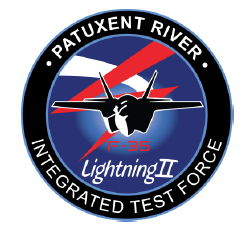
The F-35 as it evolves its software, and its ability to shape a more integrated combat capability in the extended battlespace is about a 21st century “no platform fights alone” capability; it is not about getting ever more proficient in yesterday’s tactics, and systems; it is about a generational leap.
The ITF at Pax understands this and is a key driver for such change.
The future is in good hands if the quality of the three members of the ITF interviewed about UK developments is any measure of the way ahead.
The first member of the discussion about UK engagement was with Gordon Stewart, UK MoD engineer, with significant Harrier experience and a key participant in recent ski jump testing.
The second member was Squadron Leader Andy “Gary” Edgell, RAF Test Pilot, who is an experienced Harrier pilot and extensively involved in the F-35B and F-35C testing process.
The third member was Tom Briggs, who was part of an earlier group of interviews, and is the F-35 Pax River ITF Air Vehicle Chief Test Engineer, who works closely with the Brits in shaping the capability that will fly to the UK in the form of the first IOC UK squadron in 2018.
As we have noted earlier, the UK is shaping its first operational squadron in the US, which will then fly to the UK in 2018 in time for the Queen Elizabeth sea trials. At the same time, the UK is building out its UK infrastructure to move forward as a key element of what will eventually become a European F-35 air enterprise.
In blunt terms, this means that the UK will have its aircraft at least three years earlier than if relied simply on building its own infrastructure and then generating an operational squadron from that infrastructure. This is a factor, which is largely ignored by the critics of the program.
Question: How does the ITF work from a UK point of view?
Gordon Stewart: “Let me speak to my case.
I am employed by QinetiQ, but I am working here on behalf of the UK Ministry of Defence.
At the ITF, there around 900 people working here with the vast majority being U.S. Around 2/3s of the work force are contractors, and a third is government, and within that mix there are a number of UK nationals.
The UK is the only level one partner in the F-35 program, which means that we are more closely involved in the test phase of the program than other partners.
And, in my case, I work as a Flying Qualities (FQ) engineer on the 30-40 person FQ team as an integrated member.
As FQ engineers, we look at things like flight control laws and how the pilot interacts with those controls and what the aircraft feels like to fly in a wide range of conditions.
Where we do identify issues as we expand into new areas of the flight envelope, we work closely with the control law designers in Fort Worth to have those issues resolved.
We deal with the software that relates to flight controls, and those systems feeding data into the flight controls from the mission systems. Things like how the aircraft is going to get information from the ship as to where it is, what direction it is going, or how fast it is going.
There are pieces of that which feed into the flight controls to help with recovering the aircraft to the ship and making that whole process safer, and more effective.”
Question: The UK is making a joint investment in development and your role is to have a foot in both camps so to speak.
You deal directly with the UK airworthiness certification process as well from the standpoint of being dual hatted within the ITF?
Gordon Stewart: “Part of my job is operating in the same role as the US personnel. This gives me the benefit of direct involvement in the program at a working level, and allows the ITF team here to benefit from my UK STOVL test experience.
At the same time, my engagement here helps the UK process, for when the UK-based airworthiness team has a question back in the UK, we are often able to provide answers based on our unique position here within the ITF.
I was involved with the DT-II Short Takeoff and Vertical Landing (STOVL) testing aboard USS Wasp and in the preparations for STOVL DT-III this fall. This type of UK involvement in US ship trials allows us to feed our experience into the planning for UK First of Class Flight Trials on HMS Queen Elizabeth.”
Question: The integrated part of the F-35 effort is often ignored.
How would you describe the approach to integration in the test team at Pax River?
Gordon Stewart: “This is the most integrated test team I have ever worked on.
As we work the way ahead, it might be a UK person, a Lockheed person, or a US government person who provides the best solution. It is a very well integrated team at the working level.
It is a very different test process than in the past, although what is happening in the F-35 program is the way we are approaching the future as well. In the past, there was much more serial testing.
Twenty years ago when I first started, the contractor would do something and then throw it over the fence to the government, which would look at it, approve it and then pass it on to the operator.
Now with the pace of technology, and the role of software, we have a much more integrated process. We are shaping the evolution of the aircraft as it goes out the door as well.
At Pax, we are testing a software version ahead or a couple ahead of what the fleet is getting at the moment. In effect, we are testing the next iteration of the aircraft.
And the Edwards and Beaufort efforts provide important pieces to the evolution as well. We have an integrated RAF and Royal Navy team at Edwards. 17 (R) squadron at Edwards is a mix of RAF and RN.
At Beaufort, we have a UK team and one of our aircraft, and we are working closely with the USMC. That is another key element of the joint integrated effort, from our point of view.”
Question: You are part of the F-35B process as well as the coming of the new UK carrier.
What changes involved with the ship affect the F-35B and how does the F-35B handling process affect the ship?
This question was discussed by both Gordon Stewart and Squadron Leader Edgell and they focused on four key elements.
First, the handling qualities of the aircraft are so dramatically different from the Harrier that they could approach ship operations very differently.
Rather than being heavily focused on flying the airplane, they could focus upon the mission.
Squadron Leader Edgell: “I can still remember vividly a Harrier flight from HMS Illustrious in really rough sea conditions where I launched to conduct 1v1 training with the Typhoon.
As I was fighting the Typhoon, the whole time, in the back of my mind, I was thinking of the difficulties that awaited me when recovering to the carrier.
My mind was not fully on the task of fighting the Typhoon because I was concerned with the challenges that lay ahead.
With the F-35B, this problem is significantly ameliorated. The whole confidence factor of getting home safely is just another step in the generational jump provided by this aircraft.”
Second, the U.S. was building the Joint Precision Approach and Landing System (JPALS) as the ship-air integration pairing system; the Brits were building in a new system, the Bedford Array Landing System, onboard the carriers, to work with the F-35 man-machine system, to enhance the safety and effectiveness of landing at sea.
Squadron Leader Edgell: “The Bedford Array Landing System is a formation of lights embedded within the deck.
When the ship is pitching, then the system compensates by changing which lights are illuminated so that from the pilot’s perspective he has a fixed aim point for landing.
But, in reality, the aim point is actually moving up and down the deck.”
Third, the UK carrier and its ski jump provided a way to better use deck space.
Gordon Stewart: “The ski jump offers improved take off performance compared to a flat deck take off.
For a heavily loaded jet, this translates into a shorter deck run or lower wind over deck requirements, which offers the ship flexibility in how the deck is used.”
Fourth, based on all of the above, the UK was very successfully pioneering SRVL or Shipboard Rolling Vertical Landings.
Squadron Leader Edgell: “Normally, RVL (a slow speed, fixed glidepath approach in the semi-jetborne flight regime) is a land-based recovery option. Historically, when we took Harriers back to a ship, we recovered via a vertical landing, which is purely jetborne flight.
Given the culmination of various qualities of the F-35B, we can now conduct semi-jetborne rolling vertical landings onto the carrier, known as Shipborne RVLs. Using the additional airflow over the wing, and the subsequent gain in lift, this approach provides flexibility in operations due to the extra ‘bring back’ – a term given to payload returning to the carrier vice jettisoning prior to recovery.”
We then returned to the earlier discussion of the ITF approach and its future.
But, prior to that we asked Tom Briggs to clarify what has become almost the holy writ for some analysts, namely, that the F-35B engine is a showstopper for the decks of the ships on which it will land, because of the impact of engine heat on the deck.
Briggs: “We have focused on this from the beginning and it is clearly not a show stopper — and, at this point, not even a serious issue.
When we were on the first sea trials aboard the Wasp there was deck degradation from a hot engine, but that engine belonged to the Osprey. The landing was not perfect, so there was some deck scorching from the Osprey engine.
It’s not that the F-35B engine is not putting out a lot of heat; it is.
But, in part, the flight control system and the propulsion system are controlling that output and reducing the amount of time you’re exposing heat onto the flight deck.”
The next DT test will focus in part on the F-35B and its flying qualities in terms of operations in higher sea states and difficult sea operating conditions.
Gordon Stewart: From a purely handling point of view, we expect this aircraft to operate much better than the Harrier in returning to the ship in difficult sea states.
We expect to have better systems to guide you back to the ship and to get you on there more safely and effectively.”
The F-35 integrated test approach is both a glimpse of the future as well as a foundation for that future.
The fusion cockpit of the aircraft, as well as the integration of the fleet and its impact and its ability to extend the reach of the carrier as part of integrated operations, provides a challenge to reshape the testing approach going forward.
According to Briggs: “So we’re getting at F-35 now.
But, if you take a look at some of the initiatives that are going on with the integrated warfare capabilities, and how you are going to marry up its sensors, its fusion engine, how you stimulate it, how it responds, and how you integrate them into a network architecture — that is where we are going.
It is not an in and of itself aircraft.
It is a significant network enabler.
In the test community, and for the F-35 this is mostly at Edwards, we are taking a look at how the aircraft, the ship, the satellites are responding, communicating, talking, displaying. There is a lot of effort going on in that. The Navy’s spent a fair amount in their network integrated warfare capability.”
And, it should be noted that the next partner to benefit from Pax River for its F-35 program will be Italy.
Recently, Italy flew its second Italian built F-35, known as AL-2.
February 4, its mate AL-1 will fly across the Atlantic fueled by an Italian KC-767A tanker to Pax River for further testing.
This is just another example of the collaborative approach built into the F-35 program.
Editor’s Note: What the Pax River testers are doing is concurrent testing, not serial testing. As the testers made clear throughout the visit, this is the way ahead, not going back to serial testing.
Secretary Wynne made this point during a visit to Eglin AFB in the fall of 2013.
After his presentation to the leadership of the 33rd Fighter Wing, Secretary Wynne was asked to discuss the challenge of what is called concurrency. The answer by Wynne provided one of the best understandings of the reality of the approach taken in the modern aerospace industry.
There would have to be concurrency no matter when you started the process.
Because we tend, in industry, to hire to a very tight line; enough to get the job done; but not enough to be accused of introducing an overrun. As a result, we do not see the funding to the full up line that industry would like to maximize efficiencies.
And industry will not put people on until they get slightly behind schedule. This is because we’re so worried about people cutting the program back, as the start is usually contentious, and up the line customers threaten to leave us high and dry and having to lay off a bunch of recently hired people.
And the other thing is one does not discover many problems until we get later in the program. The top-level design is roughly perfect; with the devil in the details. This is called integration.
Concurrency tends to sway like a pendulum of a clock from we want to involve the users early because we want the user feedback, and we want the engineers to get beat up and understand that they screwed up in the design. This is called direct feedback.
But you can’t get that if you wait, wait, wait, wait, and then have the tests and all your engineers have gone onto other projects, and they never actually meet the user because we waited so long.
And then the other side of it is, if you waited, would you really have solved that problem?
I don’t know.
It is a question of balance. Every program manager is going to be subject to demands to meet the IOC as quickly as possible versus counter demands that they should’ve waited and fed in changes to airplanes number one through twenty before going operational. Only when top leadership takes overt possession of the Program Manager’s (PM’s) dilemma is it called concurrency.
We will always want to feed in the air changes to airplanes one through twenty.
But doing development without deployment guarantees you will not have a new asset out there reshaping capability.
It also guarantees that the impact on operations will be shaped by testers, and not by operators.


